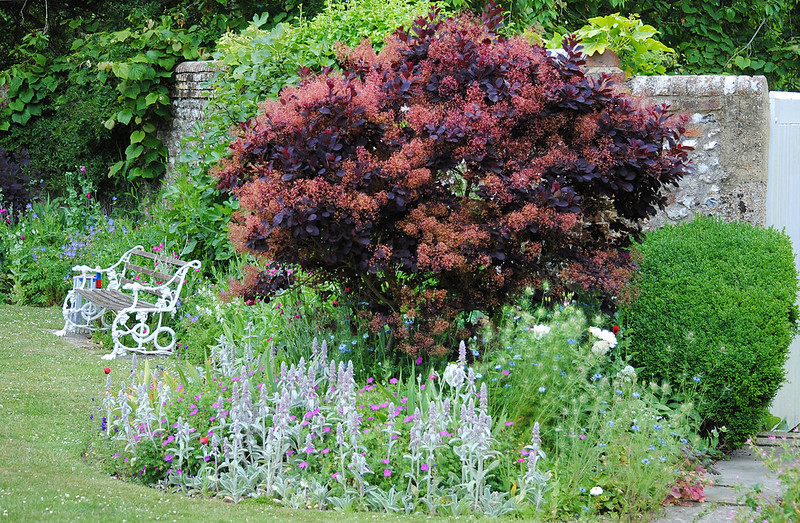A smoke tree or smoke bush is a deciduous shrub with a tree-like form that easily stands out in a landscape due to its showy flowers. However, smoke trees can be an integral part of a well-coordinated landscape. Plant smoke trees in full sun, in acidic or alkaline soil. New plants need regular water, but established plants are drought tolerant, making them a good fit for dry climates or forgetful gardeners.
Smoke trees have waxy foliage that can be green or purple, depending on the cultivar. The leaves put on a stunning and colorful display in the fall, but the real eye-catching part of this tree is the flowers. Pinkish-purple flowers have a feathery appearance, creating a cloud or smoke-like look. Smoke trees bloom in late spring and early summer, and the flowers gradually become darker as the bloom cycle progresses. Pair smoke trees with showy plants like mock orange, blazing star liatris, or canna for an over-the-top mixed planting. Create a subdued look by planting smoke trees along with boxwood, willow, or lambs ear.

Photo by Mark Wordy, unmodified, Flickr, copyright CC BY 2.0 DEED
Shrubs To Plant With Smoke Trees
The consistent greenery of boxwood serves as a wonderful backdrop for smoke trees. Boxwood can be pruned into a formal shape, providing a lovely contrast to the puffy organic form of smoke tree. The glossy foliage of both plants provides some consistency, but the flower plumes will stand out during the blooming season.
The ruffled petals and sweet fragrance of mock orange make this bush a welcome addition to any landscape. Mock orange blooms around the same time as smoke trees, creating a truly spectacular space. Both plants feature lovely foliage that stays in place after the flowers fade before dropping in the fall.
Willow and buckeye are trees that work well with smoke trees. The gently arching willow branches and narrow leaves provide color and texture without competing with the smoke tree. The buckeye features feathery white flowers late in the summer after the smoke tree is done blooming, and the foliage turns dramatic shades during the fall. Willows and buckeyes often grow taller than smoke trees, but all of these plants prefer full sun, so position them so each tree receives the sunlight it needs.
Perennials To Plant With Smoke Trees
The unique look of the blazing star liatris complements the showy appearance of the smoke tree. Tall, upright flower spikes can reach several feet high, and the flowers have hair-like structures, creating a feathery appearance similar to the smoke tree’s blooms. Plant blazing star liatris around the base of a smoke tree, but ensure this flowering perennial receives full sun.
Allium and salvia are flowering perennials that provide dependable color. The rounded, orb-like allium flowers provide texture, complementing the smoke tree blooms. The small salvia blooms grow along tall stems and make a nice understory planting for smoke trees. All three plants require minimal supplemental water and care once established.
Plant lilies to add a bold burst of color during the summer or fall. Feature lilies under a smoke tree since these flowering perennials can reach several feet tall. Lambs ear is a spreading perennial that makes a wonderful ground cover. This flowering perennial is known for its often fuzzy foliage, but it also blooms during the spring and summer. Plant lamb’s ear in a sunny spot so its silvery foliage is near the smoke tree’s purple or chartreuse foliage.

Photo by cultivar413, unmodified, Flickr, copyright CC BY 2.0 DEED
Annuals To Plant With Smoke Trees
Smoke trees leave a big impression on a landscape, but annuals like dahlia will make an equally big impression. Dahlia flowers often measure several inches wide and feature rows of colorful petals, creating a full and stunning bloom. Plant dahlias in full sun and enjoy the flowers from spring through frost. The star-shaped flowers of Nicotiana open during the night throughout the summer and fall, making them a favorite of nighttime pollinators. This plant needs full sun to partial shade, and growing under a smoke tree ensures the nicotiana receives the right amount of sunlight.
The tropical-looking canna makes for an unexpected companion with smoke trees, but this match works. Cannas stand several feet tall and live in partial to full sun. These annuals are surprisingly drought tolerant but do best when they receive water during a dry period.
Best Companion Plants For Smoke Trees in Containers
Hardy geraniums have a low and dense growth habit, making them a good option in containers because the reaching stems will fill in the base of the container and extend over the edge of the pot. The flower color will echo the foliage and bloom color of smoke tree. You can expect dependable flowers during the spring, summer, and fall, making hardy geraniums a good companion plant for a potted smoke tree.
Plants Not To Grow With Smoke Trees
Smoke trees are adaptable and hands-off once established, but these showy and easy-going trees grow best with plants that have similar care needs. Taller trees, like maples can potentially block sunlight and should not be positioned to cast shade on the smoke tree. Plants with increased water needs are unsuitable for smoking trees, so avoid planting Joe Pye weed and dogwood nearby.
Best Plants To Grow With Smoke Trees
Smoke trees are stunning on their own but look lovely with sun-loving companions that can handle dry growing conditions. Boxwood, mock orange, canna, and hardy geraniums grow well with smoke trees. Play around with contrasting shapes to draw the eye even when the flowers have faded.
 |
Author Alison Cotsonas - Published 10-16-2023 |
